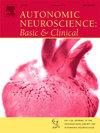Can ‘noisy data’ perform as well as ‘clean data’ in outcome modeling after aneurysmal subarachnoid haemorrhage?
IF 3.3
4区 医学
Q2 NEUROSCIENCES
引用次数: 0
Abstract
Background
Baroreflex sensitivity (BRS) is associated with clinical outcome in patients with aneurysmal subarachnoid haemorrhage (aSAH); however few studies have investigated this in typical clinical settings. This two-centre study evaluated how outcome models differ when excluding patients who received beta-blockers and/or noradrenaline (‘clean data’ set) versus including all of them (‘noisy data’ set).
Methods
This retrospective study included consecutive aSAH patients from Addenbrooke's Hospital (UK) and Wroclaw Medical University (Poland). Early BRS was measured using the cross-correlation method. A favorable outcome was defined as a Glasgow Outcome Scale (GOS) score of 4–5 at discharge.
Results
A total of 108 patients were included, with 40 receiving beta-blockers and/or noradrenaline. The median age was 56 (IQR ± 17) years old, where 73 % were women. On admission, 57 % had a Glasgow Coma Scale (GCS) score of 13–15. Univariate logistic regression showed BRS was significantly associated with outcome in both the ‘clean data’ set (OR 1.16, 95%CI [1.02,1.30]) and ‘noisy data’ set (OR 1.10, 95%CI [1.03,1.18]). In multivariate analysis, the best ‘clean data’ model (χ2 = 22.89, p < 0.001, AUC = 0.88) included heart rate (HR) (OR 0.93, 95%CI [0.87,0.99]) and GCS (OR 1.38, 95%CI [1.12,1.69]). The best ‘noisy data’ model (χ2 = 32.27; p < 0.001, AUC = 0.84) included BRS (OR 1.10, 95%CI [1.01,1.20]) and GCS (OR 1.32, 95%CI [1.16,1.51]).
Conclusions
Early BRS was independently associated with short-term outcome after aSAH, regardless of beta-blockers or noradrenaline use. In the ‘clean data’ set, HR was significantly associated with outcome, whilst in the ‘noisy data’ set, BRS was significantly associated with outcome. A larger multicentre study is required to validate these findings.
在动脉瘤性蛛网膜下腔出血后的结果建模中,“嘈杂数据”是否能与“干净数据”表现得一样好?
背景:压力反射敏感性(BRS)与动脉瘤性蛛网膜下腔出血(aSAH)患者的临床结果相关;然而,很少有研究在典型的临床环境中对此进行调查。这项双中心研究评估了在排除接受β受体阻滞剂和/或去甲肾上腺素治疗的患者(“干净数据”组)与包括所有患者(“嘈杂数据”组)时结果模型的差异。方法回顾性研究包括来自英国阿登布鲁克医院和波兰弗罗茨瓦夫医科大学的连续aSAH患者。早期BRS采用互相关法测定。出院时格拉斯哥预后量表(GOS)评分为4-5分即为良好预后。结果共纳入108例患者,其中40例接受β受体阻滞剂和/或去甲肾上腺素治疗。中位年龄为56 (IQR±17)岁,其中73%为女性。入院时,57%的患者格拉斯哥昏迷评分(GCS)为13-15分。单因素logistic回归显示,在“干净数据”集(OR 1.16, 95%CI[1.02,1.30])和“嘈杂数据”集(OR 1.10, 95%CI[1.03,1.18])中,BRS与结果均显著相关。在多变量分析中,最佳的“干净数据”模型(χ2 = 22.89, p <;0.001, AUC = 0.88)包括心率(OR 0.93, 95%CI[0.87,0.99])和GCS (OR 1.38, 95%CI[1.12,1.69])。最佳“噪声数据”模型(χ2 = 32.27;p & lt;0.001, AUC = 0.84)包括BRS (OR 1.10, 95%CI[1.01,1.20])和GCS (OR 1.32, 95%CI[1.16,1.51])。结论早期BRS与aSAH后的短期预后独立相关,与使用β受体阻滞剂或去甲肾上腺素无关。在“干净数据”集中,HR与结果显著相关,而在“嘈杂数据”集中,BRS与结果显著相关。需要更大规模的多中心研究来验证这些发现。
本文章由计算机程序翻译,如有差异,请以英文原文为准。
求助全文
约1分钟内获得全文
求助全文
来源期刊
CiteScore
5.80
自引率
7.40%
发文量
83
审稿时长
66 days
期刊介绍:
This is an international journal with broad coverage of all aspects of the autonomic nervous system in man and animals. The main areas of interest include the innervation of blood vessels and viscera, autonomic ganglia, efferent and afferent autonomic pathways, and autonomic nuclei and pathways in the central nervous system.
The Editors will consider papers that deal with any aspect of the autonomic nervous system, including structure, physiology, pharmacology, biochemistry, development, evolution, ageing, behavioural aspects, integrative role and influence on emotional and physical states of the body. Interdisciplinary studies will be encouraged. Studies dealing with human pathology will be also welcome.

 求助内容:
求助内容: 应助结果提醒方式:
应助结果提醒方式:


